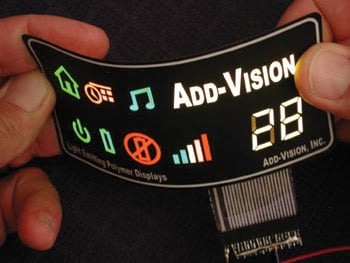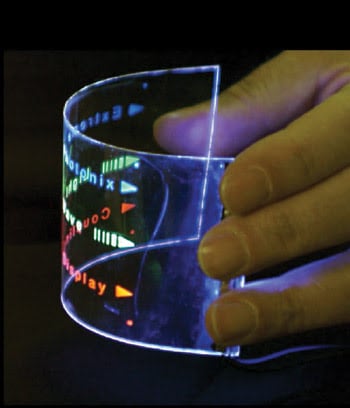Alternative materials and low-cost printing technologies are needed to push flexible displays to the forefront.
Mark Fihn, Veritas et Visus
One exciting area in the flat panel display industry is the emergence of flexible displays. In recent years, LCDs have dominated the industry, but they are glass-based solutions. Hundreds of companies are working to devise displays built on plastic, metal foils or other flexible substrates in an effort to dislodge the pre-eminent LCDs.
The auto industry has been relatively slow in adopting LCDs. This is due not to a lack of effort on the part of car manufacturers, but rather because automotive displays must meet very strict safety-related requirements and function in extreme environmental conditions. Although LCDs work well for notebook PCs and TVs, they do not function well in freezing temperatures and are not adequate for the ambient brightness that automobiles encounter on a sunny day. Thus, the automotive industry has been paying very close attention to developments associated with flexible substrates.

Simple displays are already being developed on flexible substrates for the automotive market, such as this light-emitting polymer device from Add-Vision. Courtesy of Add-Vision.
Moving from glass to a flexible substrate is not a simple matter, however. One of the biggest problems associated with plastic substrates is that they require relatively low manufacturing processing temperatures, typically much lower than required by the underlying display electronics. Finding an appropriate balance between the characteristics of the plastic and display manufacturing processes has been a challenge, which makes alternatives such as steel foil and flexible glass attractive.
Perhaps the biggest obstacle to using plastic as a substrate for flexible displays is that, because plastic does not provide an adequate barrier against water and oxygen permeation, the delicate electrical and chemical materials can be destroyed quickly. Adding layers is not always a good solution for flexible displays because each time a layer is added, the elastomeric and thermal properties of the materials cause varying effects. These effects are trouble enough on a flat surface, but they cause all kinds of problems on flexible surfaces.
Specifically, the transparent, conductive layer is one of the most problematic encountered by display manufacturers. The most popular transparent conductor is indium tin oxide, but it is brittle and cracks easily when flexed. Many companies are working on alternatives to ITO that enable similar conductivity and transparency while meeting the challenges of flexibility.
In addition, dislodging glass-based LCDs from their position poses a significant challenge. With new LCD fabrications costing up to $3 billion (plus additional investments for subcomponents), many argue that LCD manufacturers have created a barrier to entry that is unassailable by alternative technologies. Proponents of flexible displays, however, argue that if the large-scale LCD fabrications, which are based on batch processing of photolithographic and vapor deposition processes, can be replaced with low-cost printing technologies, the LCD’s infrastructure will not be as much of a barrier to entry as it will be a burden.
To address the LCD juggernaut, flexible display manufacturers are hoping to find a “killer application” that will propel the business into large-scale production. Although computing and entertainment devices are likely to continue to be supported by LCDs for the foreseeable future, many are hopeful that books, magazines and newspapers may transition to flexible display technologies as an alternative to paper.
Other prime candidates include signage (both point-of-purchase and large-scale billboards), labeling (for things such as retail shelf edges), smart card devices with integrated displays and a variety of automotive applications.
Automakers are keenly interested in display solutions built on flexible substrates that will enable curved surfaces (such as windshields and dashboards), but opportunities also exist for such diverse products as license plates, bumper stickers, rear-view mirrors with embedded functions, and the obvious navigation, entertainment, communications and control systems that are quickly becoming popular in today’s cars. Less obvious are the possibilities associated with styling. An auto’s upholstery (another flexible substrate), for example, might be electronically adjustable so that interior colors could be changed with the push of a button. Eventually, the painted surface of the exterior design may be similarly adjustable, depending on user preferences and traffic safety requirements.

Conformable surfaces using novel materials (such as electrowetting display devices) are being investigated by automobile companies for dashboard and control applications. Courtesy of the University of Cincinnati.
Although there remain substantial technical and economic hurdles to the full realization of flexible displays in the auto industry, there is no doubt that increasingly we will see devices built on nonglass substrates. The advantages of shifting to flexible substrates, both from an application and a manufacturing perspective, are substantial. Although probably still a few years away, it seems likely that the automotive industry will be one of the early adopters of flexible displays.
Meet the author
Mark Fihn is the publisher at Veritas et Visus, which publishes Flexible Substrate, a newsletter that provides news about and market analysis of the flat panel display industry; e-mail: [email protected].